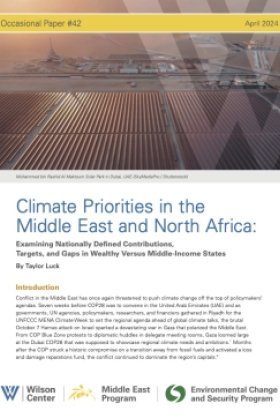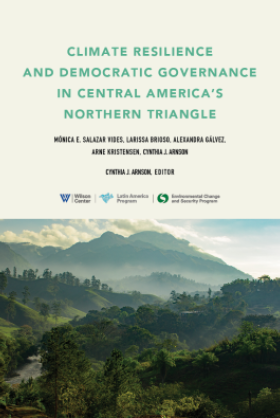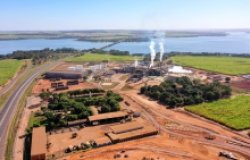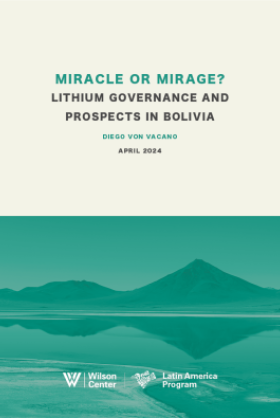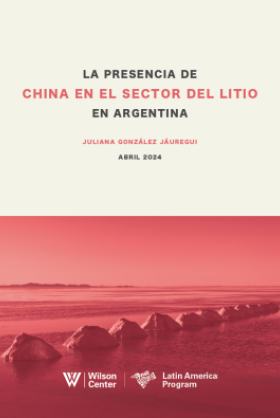Population Growth, Environmental Degradation, and State-Sponsored Violence: The Case of Kenya, 1991-93
Colin H. Kahl, Research Associate, Columbia's Center for International Earth Science Information Network CIESIN; Kent H. Butts, George C. Marshall Chair, Center for Strategic Leadership, U.S. Army War College
Overview
Colin H. Kahl, Research Associate, Columbia's Center for International Earth Science Information Network CIESIN;
Kent H. Butts, George C. Marshall Chair, Center for Strategic Leadership, U.S. Army War College
 Demographic and environmental stress can be causes of civil strife when social schisms caused by natural resource scarcities and related social grievances create incentives and opportunities for state elites to engage in violence, according to Colin Kahl, speaking at a recent meeting co-sponsored by ECSP and the Africa Project of the Wilson Center. Kahl, a research associate at Columbia's Center for International Earth Science Information Network (CIESIN), addressed a group of practitioners, policymakers, and NGO representatives on the interrelationships among the three issues of population growth, environmental degradation, and violent conflict. Kent Butts of the U.S. Army War College provided critical comments that centered on the applicability of Kahl's research in formulating policy, including the need to adjust the hypothesis to account for different political, social, and historical factors in each case study.
Demographic and environmental stress can be causes of civil strife when social schisms caused by natural resource scarcities and related social grievances create incentives and opportunities for state elites to engage in violence, according to Colin Kahl, speaking at a recent meeting co-sponsored by ECSP and the Africa Project of the Wilson Center. Kahl, a research associate at Columbia's Center for International Earth Science Information Network (CIESIN), addressed a group of practitioners, policymakers, and NGO representatives on the interrelationships among the three issues of population growth, environmental degradation, and violent conflict. Kent Butts of the U.S. Army War College provided critical comments that centered on the applicability of Kahl's research in formulating policy, including the need to adjust the hypothesis to account for different political, social, and historical factors in each case study.
Kahl argued that many scholars and practitioners have largely ignored the role of state exploitation and violence when examining the intersection between the issues of population, natural resource scarcity, and violent conflict. As such, Kahl has developed a state exploitation hypothesis that "generates several first- and second-tier effects" that could lead to conflict when combined with particular political institutions and forms of social organizations. The three important first-tier effects are renewable resource scarcity, economic marginalization, and demographic shifts. The two key second-tier effects are increased social grievances and state weakness. State weakness is the concept that factors like environmentaldegradation, resource scarcity, and population growth will lead to internal strife only if the strife will create "incentives and opportunities" for both individuals and groups to engage in violent behavior.
 In developing this hypothesis, Kahl also argued that it is crucial to have explicit definitions of what environmental and demographic stress, civil strife, and the state entail. For Kahl, environmental and demographic stress is "a composite variable encompassing (1) population growth; and (2) the degradation, depletion, and/or mal-distribution of renewable resources." These renewable resources include for example, arable land, fresh water, forests, and fisheries. "Large-scale, sustained, and organized violent conflict within a political entity" which can include campaigns of terrorism, rebellion, insurgency, civil war, and revolution but not crime or riots, constitute civil strife according to Kahl. The state, meanwhile, is composed of "a set of governing institutions and organizations led and coordinated by individuals occupying offices that authorize them to make and implement binding rules for all people within a territorially demarcated area."
In developing this hypothesis, Kahl also argued that it is crucial to have explicit definitions of what environmental and demographic stress, civil strife, and the state entail. For Kahl, environmental and demographic stress is "a composite variable encompassing (1) population growth; and (2) the degradation, depletion, and/or mal-distribution of renewable resources." These renewable resources include for example, arable land, fresh water, forests, and fisheries. "Large-scale, sustained, and organized violent conflict within a political entity" which can include campaigns of terrorism, rebellion, insurgency, civil war, and revolution but not crime or riots, constitute civil strife according to Kahl. The state, meanwhile, is composed of "a set of governing institutions and organizations led and coordinated by individuals occupying offices that authorize them to make and implement binding rules for all people within a territorially demarcated area."
There are two intervening variables that must be considered in assessing whether state exploitation dynamics are likely to lead to civil strife. The two variables are institutional inclusivity and groupness. The inclusivity of state institutions refers to the degree to which key social groups are institutionally empowered to participate in, and influence, decision-making by state elites. In an exclusive state, on the other hand, decisions are made by a narrow group of state elites, allowing them and their allies "to exploit resource scarcities to manipulate social schisms to advance their narrow self-interests, because the social costs of such policies are spread out across society while the benefits are accrued by the narrow clique at the top."
Groupness, the second variable, refers to the degree to which "clusters of individuals depend on distinct identity-groups (whether they be ethno-cultural, kin-, tribe-, religious-, or class-based) for physical, economic, and psychic security, as opposed to a number of overlapping and cross-cutting identity-groups." Thus, the greater degree of groupness in a society, the more likely the tendency will be toward organized violence, while a low degree of groupness makes conflict less likely.
In looking at the role that state violence could play in countries plagued by severe population and environmental pressures, Kahl used the series of events that unfolded in Kenya, leading to violent conflict from 1991 to 1993 as a case study. Conflict became more likely according to Kahl's hypothesis, since Kenya was an exclusionary state with a high degree of uneven groupness. These two intervening variables created "incentives and opportunities" for state elites to exploit the natural resource scarcities in Kenya, leading to civil strife.
Kahl discussed the historical, political, and social factors of Kenya that he argues led to conflict when combined with the intervening and environmental and demographic variables discussed earlier. He provided an overview of the impact of the British colonial structure, the political division of the ethnic groups into two main factions, and the highly developed nationalistic sentiments among the ethnic groups.
Next, Kahl looked at the rapid and uneven population explosion in Kenya and the resulting land scarcity, which created sources of inter-ethnic and political strife. Adding to all this pressure, Kahl argues that the state exploited this natural resource scarcity, in an environment of exclusive institutions and uneven groupness, contributing to an outbreak of violence.
 Butts' comments focused on the need for similar research exploring the links between population growth, environmental scarcity, and violent conflict. Both researchers and policymakers must work together to identify the drivers that will increase stability and provide scarcity solutions for the Third World, such as technology and population issues as they relate to land, including accessibility and availability for all parties. He also stressed the need for the developed world to work with the governments of the developing world to find solutions to that will enhance local, regional, and global security by addressing natural resource scarcity and population issues.
Butts' comments focused on the need for similar research exploring the links between population growth, environmental scarcity, and violent conflict. Both researchers and policymakers must work together to identify the drivers that will increase stability and provide scarcity solutions for the Third World, such as technology and population issues as they relate to land, including accessibility and availability for all parties. He also stressed the need for the developed world to work with the governments of the developing world to find solutions to that will enhance local, regional, and global security by addressing natural resource scarcity and population issues.
This was an opportunity for practitioners and experts in the fields of population, environment, security, and the region of Africa to hear a political scientist's views on the role that the different issues play. The discussion focused on the need to incorporate more political, social, and economic issues into the model that Kahl developed as well as the ways that this research may be utilized in US foreign policy. Several participants stressed that studies such as Kahl's can provide the tools to evaluate different situations around the world and formulate short-, mid-, and long-term policies to diffuse existing and deter potential conflicts. Building upon the work of other scholars such as Jack Goldstone and Thomas F. Homer-Dixon, Kahl emphasized that in his research demographic and environmental stresses are neither necessary nor wholly sufficient causes of violent conflict, acknowledging the participant's criticisms that other variables must be included when evaluating a crisis.
For more information, please see Kahl's article similarly entitled "Population Growth, Environmental Degradation, and State-Sponsored Violence: The Case of Kenya, 1991-93, in International Security, volume 23, no. 2 (fall 1998).
Please visit the Woodrow Wilson Center's Africa Project webpage for more information on its activities and topics.
Hosted By

Environmental Change and Security Program
The Environmental Change and Security Program (ECSP) explores the connections between environmental change, health, and population dynamics and their links to conflict, human insecurity, and foreign policy. Read more
Thank you for your interest in this event. Please send any feedback or questions to our Events staff.
